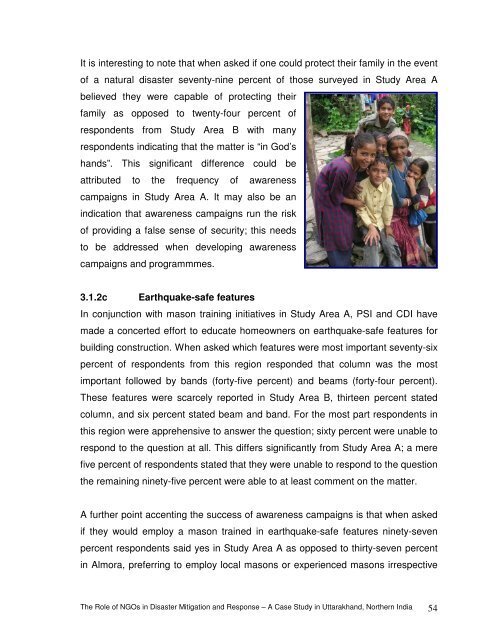A Case Study in Uttarakhand, Northern India - Geological & Mining ...
A Case Study in Uttarakhand, Northern India - Geological & Mining ...
A Case Study in Uttarakhand, Northern India - Geological & Mining ...
- No tags were found...
Create successful ePaper yourself
Turn your PDF publications into a flip-book with our unique Google optimized e-Paper software.
It is <strong>in</strong>terest<strong>in</strong>g to note that when asked if one could protect their family <strong>in</strong> the eventof a natural disaster seventy-n<strong>in</strong>e percent of those surveyed <strong>in</strong> <strong>Study</strong> Area Abelieved they were capable of protect<strong>in</strong>g theirfamily as opposed to twenty-four percent ofrespondents from <strong>Study</strong> Area B with manyrespondents <strong>in</strong>dicat<strong>in</strong>g that the matter is “<strong>in</strong> God’shands”. This significant difference could beattributed to the frequency of awarenesscampaigns <strong>in</strong> <strong>Study</strong> Area A. It may also be an<strong>in</strong>dication that awareness campaigns run the riskof provid<strong>in</strong>g a false sense of security; this needsto be addressed when develop<strong>in</strong>g awarenesscampaigns and programmmes.3.1.2c Earthquake-safe featuresIn conjunction with mason tra<strong>in</strong><strong>in</strong>g <strong>in</strong>itiatives <strong>in</strong> <strong>Study</strong> Area A, PSI and CDI havemade a concerted effort to educate homeowners on earthquake-safe features forbuild<strong>in</strong>g construction. When asked which features were most important seventy-sixpercent of respondents from this region responded that column was the mostimportant followed by bands (forty-five percent) and beams (forty-four percent).These features were scarcely reported <strong>in</strong> <strong>Study</strong> Area B, thirteen percent statedcolumn, and six percent stated beam and band. For the most part respondents <strong>in</strong>this region were apprehensive to answer the question; sixty percent were unable torespond to the question at all. This differs significantly from <strong>Study</strong> Area A; a merefive percent of respondents stated that they were unable to respond to the questionthe rema<strong>in</strong><strong>in</strong>g n<strong>in</strong>ety-five percent were able to at least comment on the matter.A further po<strong>in</strong>t accent<strong>in</strong>g the success of awareness campaigns is that when askedif they would employ a mason tra<strong>in</strong>ed <strong>in</strong> earthquake-safe features n<strong>in</strong>ety-sevenpercent respondents said yes <strong>in</strong> <strong>Study</strong> Area A as opposed to thirty-seven percent<strong>in</strong> Almora, preferr<strong>in</strong>g to employ local masons or experienced masons irrespectiveThe Role of NGOs <strong>in</strong> Disaster Mitigation and Response – A <strong>Case</strong> <strong>Study</strong> <strong>in</strong> <strong>Uttarakhand</strong>, <strong>Northern</strong> <strong>India</strong> 54
















